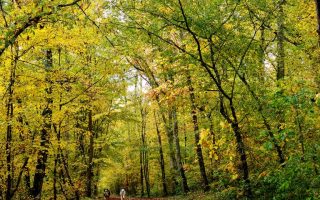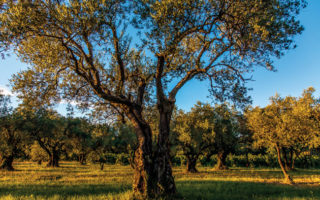Having Sheep at Your French Farm
Advice


For many smallholders, sheep are the second choice for livestock, just after chickens. For myself, it was not; in fact, it was one of my last. What I know about sheep could probably be written on the back of a matchbox.
The Upside
Sheep are by far the best lawnmowers there are. Two adult females (ewes) will also provide a small family with all the lamb they would normally eat in a year i.e. two to four lambs, preferably borrowing a ram. The wool from two ewes could be spun for knitting or made into felt, while the skins from the culled lambs will make excellent rugs.
The Downside
Sheep are not pets; while they are cute unless you are willing to invest a great deal of time in hand-taming them, they will not generally approach you. It is their nature to avoid human contact unless they require something from you i.e. food or water. Sheep need maintenance. Their feet need to be trimmed every six weeks, they need to be wormed, and they have to be sheared every year.
Trimming a sheep’s feet is imperative, and failure to do so could cripple your sheep irreversibly, either from broken or deformed hooves or from ovine foot rot, which is an interaction of two anaerobic (without oxygen) bacteria – ‘Bacteroides nodosus’ and ‘Fusobacterium necrophorum’.
Trimming sheep’s feet serves two purposes: it will keep their feet in good shape, and it will give you an early indication of any sign of ovine foot rot. Ovine foot rot is easy to spot, but more by smell than sight – the infection causes a characteristic foul odour. You will need to consult a vet if you find it in your sheep.
Worms in sheep are also a constant problem; you can simply dose them with a worming medication from your vet, or you can try to at least limit the amount of medication necessary by rotating your sheep on three different areas of land. This helps because the worms cannot live outside the sheep’s body for more than three weeks. Therefore, if you move your sheep from one pasture to another every two weeks, not returning to the first pasture for four weeks, your sheep won’t re-infect themselves with worms.
Shearing is a very skilled craft and is not for the faint-hearted; please do not try it without supervision; there are many a ewe without nipples and rams without testicles as a result of poor shearing by amateurs. A professional will make it look easy and carry out the task quickly and efficiently without harming the sheep in any way.
Here in mid-France, it costs only 2€ per sheep once a year, which is a very small cost indeed. If you were to try it yourself, the equipment alone would cost you €250 for a DIY set, and your (lack of) skill level could cost you a good ram. I would recommend you contact the professionals or ask your vendor whom he recommends and see if it’s possible to return with your sheep on the day he has his sheep sheared.
Feeding
Sheep can survive on little more than good pasture for most of the year with some high-protein grain to supplement their late autumn and early spring feeding. But in the winter, you will have to provide most of their feed. Hay is the mainstay of their diet, and good hay is best, plus some high-protein grain to top it up.
Good pasture is not just grass; it is as many as 50 different types of grasses, along with wildflowers and herbs: Perennial Rye Grass, Meadow Grass, Creeping Red Fescue, Soft Rushes, Sheep’s Fescue, Tall Fescue, Timothy, Cocksfoot, Early Rye Grass, Natural Clovers, Yarrow, Dandelion, Chicory, Comfrey and Burnet are just a few examples. Many of these plants play an important nutritional role for animals. If all you can see in your pasture on close inspection is grass, then look to introduce some of the other plants in the list above.
Sheep need a plentiful supply of good, clean water at all times; in winter, this may mean you will have to break the ice on their trough several times a day, and in summer, you will have to check on manually filled troughs just as often.
Housing Needs
This is the simplest of all the areas of sheep management. Sheep can manage without housing, but you will have to focus your reproduction timing on when it is less likely to be cold and wet. Not necessarily for the sheep, as even newborn lambs can survive a degree of cold and wet, but you will have to be out there with them as not all births of lambs are free from problems. The fact is that sheep are no longer natural animals – humans have been messing about with their gene pool for millennia, and many of today’s sheep breeds have lost the ability to deliver their young naturally. Your assistance may be required at birthing and you may well want to be warm and dry, so housing has to be big enough for you and yourewes to occupy.
Sheep are considered to be one-sixth of an animal unit; in farming terms, that means one acre of good pasture will be enough to feed a one animal unit. So, if you have good pasture, you can keep six sheep on each acre, but this is a very general rule and is open to much interpretation.
In mid-Wales, although to the untrained eye, it all looks wonderfully green and romantic, the pasture, in general, is of middle-range quality and is usually only inhabited by four sheep per acre. In the highlands of Scotland, pasture is relatively poor and is usually only inhabited by two sheep per acre. Here in central France, we have pasture, which is comparable to mid-Wales, so I only set four sheep to the acre on strict rotations.
Breeding in brief
I will cover this in more detail later, but for now, having mentioned the timing of reproduction, it seems remiss not to mention some basics. A sheep’s gestation period is about five months; it is said that if you put the ewes to the tup (ram) on the 5th of November, you will have lambs around April Fools Day.
Timing is very important when planning your lambing – naturally, ewes would have searched out the ram at times of plentiful food, knowing they would need the good pasture to help them through the early part of gestation. You can, of course, cut back your ewes’ food a little, keeping them on poorer ground for a month, then put them on good ground to do what is termed “flushing”, i.e. feed them up, then put the tup with them.
Ewes will be ready for the ram if they are feeling flush; five months later, you will notice the udder enlarge, and a couple of days later, lambs will arrive. It is best to have your pasture at its best when the lambs arrive, or you will have to supplement the feed of both the ewes and lambs at a greater financial cost to you.
However, if you put the ewes to the tup, as the saying goes, on the 5th of November, when your lambs arrive in early April, your pasture will just be coming to its best, and your lambs will grow on the spring flush.
Steve Hanson
Lead photo credit : Sheep
Share to: Facebook Twitter LinkedIn Email
More in courses, family, food, garden, land, pets, summer
By FrenchEntrée
Leave a reply
Your email address will not be published. Required fields are marked *




REPLY